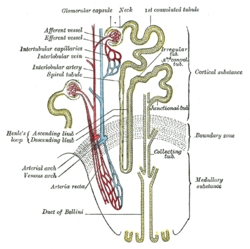Our website is made possible by displaying online advertisements to our visitors.
Please consider supporting us by disabling your ad blocker.
Loop of Henle
| Loop of Henle | |
|---|---|
 Scheme of renal tubule and its vascular supply (loop of Henle visible center-left) | |
| Details | |
| Precursor | Metanephrogenic blastema |
| Identifiers | |
| Latin | ansa nephroni |
| MeSH | D008138 |
| FMA | 17718 17698, 17718 |
| Anatomical terminology | |
In the kidney, the loop of Henle (English: /ˈhɛnli/) (or Henle's loop, Henle loop,[1] nephron loop[2] or its Latin counterpart ansa nephroni) is the portion of a nephron that leads from the proximal convoluted tubule to the distal convoluted tubule. Named after its discoverer, the German anatomist Friedrich Gustav Jakob Henle, the loop of Henle's main function is to create a concentration gradient in the medulla of the kidney.[3]
By means of a countercurrent multiplier system, which uses electrolyte pumps, the loop of Henle creates an area of high urea concentration deep in the medulla, near the papillary duct in the collecting duct system. Water present in the filtrate in the papillary duct flows through aquaporin channels out of the duct, moving passively down its concentration gradient. This process reabsorbs water and creates a concentrated urine for excretion.[3]
Previous Page Next Page


